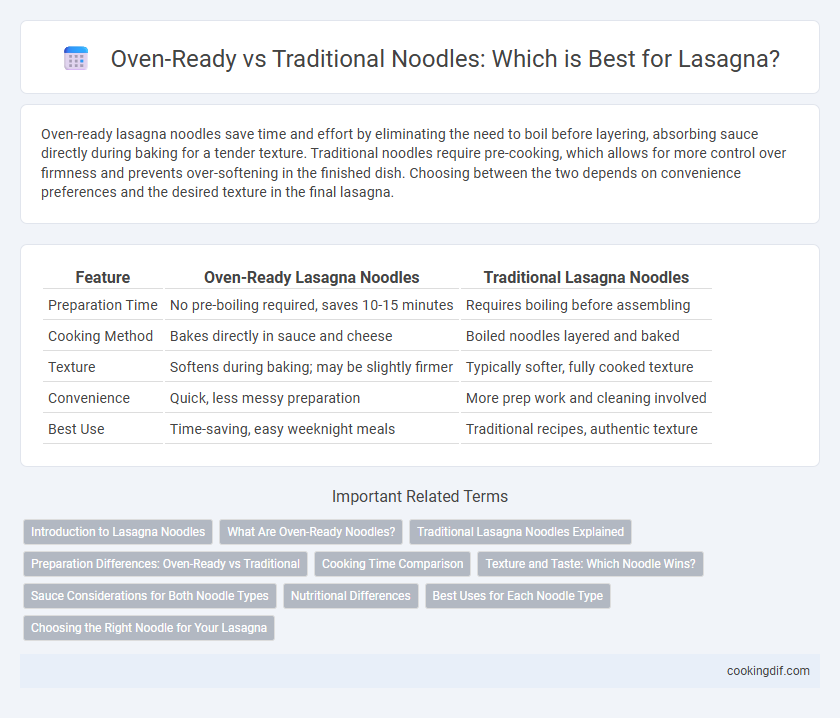Oven-ready lasagna noodles save time and effort by eliminating the need to boil before layering, absorbing sauce directly during baking for a tender texture. Traditional noodles require pre-cooking, which allows for more control over firmness and prevents over-softening in the finished dish. Choosing between the two depends on convenience preferences and the desired texture in the final lasagna.
Table of Comparison
| Feature | Oven-Ready Lasagna Noodles | Traditional Lasagna Noodles |
|---|---|---|
| Preparation Time | No pre-boiling required, saves 10-15 minutes | Requires boiling before assembling |
| Cooking Method | Bakes directly in sauce and cheese | Boiled noodles layered and baked |
| Texture | Softens during baking; may be slightly firmer | Typically softer, fully cooked texture |
| Convenience | Quick, less messy preparation | More prep work and cleaning involved |
| Best Use | Time-saving, easy weeknight meals | Traditional recipes, authentic texture |
Introduction to Lasagna Noodles
Oven-ready lasagna noodles offer convenience by eliminating the need to boil before layering, allowing for quicker assembly and reduced preparation time. Traditional noodles require pre-cooking to achieve the desired texture, which gives more control over softness and thickness. Choosing between these types depends on preferred cooking methods and desired texture consistency in the finished lasagna dish.
What Are Oven-Ready Noodles?
Oven-ready noodles are pre-cooked and thinner than traditional pasta sheets, designed to absorb sauce and cook fully during baking without boiling beforehand. They offer convenience by eliminating the pre-cooking step, reducing preparation time and simplifying the lasagna assembly process. These noodles are ideal for home cooks seeking a quicker, mess-free lasagna experience while maintaining texture and flavor.
Traditional Lasagna Noodles Explained
Traditional lasagna noodles require boiling before assembling the dish, ensuring they achieve the perfect texture and absorb flavors evenly during baking. These noodles offer greater control over doneness and prevent excess moisture in the lasagna, resulting in a firmer, more structured dish. Classic recipes often favor traditional noodles for their authentic texture and superior ability to meld with rich layers of sauce, cheese, and meat.
Preparation Differences: Oven-Ready vs Traditional
Oven-ready lasagna noodles are pre-cooked and require no boiling, allowing for faster assembly and reduced preparation time. Traditional noodles need to be boiled until al dente before layering, adding a step and extra time in the cooking process. Choosing oven-ready noodles simplifies cleanup and prevents overcooking, while traditional noodles provide more control over texture.
Cooking Time Comparison
Oven-ready lasagna noodles significantly reduce cooking time by eliminating the need to boil before assembling, allowing direct layering with sauce to soften in the oven. Traditional noodles require pre-cooking for 8 to 10 minutes, which extends overall preparation and baking time. Opting for oven-ready noodles streamlines the process, cutting total cooking time by approximately 15 to 20 minutes.
Texture and Taste: Which Noodle Wins?
Oven-ready lasagna noodles offer a smoother texture with a slightly firmer bite due to their pre-cooking process, allowing for better sauce absorption and even layering. Traditional noodles provide a more al dente experience, with a chewier texture that some prefer for a heartier taste. Taste preference often depends on desired lasagna consistency, but oven-ready noodles enhance flavor integration, while traditional noodles maintain a distinct pasta presence.
Sauce Considerations for Both Noodle Types
Oven-ready lasagna noodles absorb sauce slowly, requiring a moister sauce to ensure proper cooking and prevent dryness. Traditional noodles need to be boiled beforehand, allowing them to absorb sauce evenly during baking and maintaining optimal texture. Choosing the right sauce thickness and moisture content is crucial for achieving a perfectly cooked lasagna with either noodle type.
Nutritional Differences
Oven-ready noodles typically have a higher moisture content and fewer preservatives compared to traditional dried noodles, which can influence their nutritional profile by slightly increasing water content and reducing sodium levels. Traditional noodles often contain more calories and carbohydrates due to their denser texture and longer drying process. Both options provide similar protein and fiber amounts, but oven-ready noodles may offer a lower glycemic index due to their pre-cooked nature.
Best Uses for Each Noodle Type
Oven-ready lasagna noodles are best suited for quick and convenient recipes, as they require no pre-boiling and absorb sauce directly during baking, making them ideal for busy weeknight meals. Traditional noodles, which need to be boiled before layering, work well for recipes needing precise texture control and richer flavors, as pre-cooking allows the pasta to fully absorb seasoning and sauces. Choosing between oven-ready and traditional noodles depends on the desired cooking time and texture, with oven-ready emphasizing ease and traditional offering customization.
Choosing the Right Noodle for Your Lasagna
Oven-ready lasagna noodles offer convenience by eliminating the need for pre-boiling, saving time while absorbing sauce directly during baking for a softer texture. Traditional noodles require boiling before assembly, allowing greater control over texture and preventing overcooking, which can lead to a firmer bite and layered definition. Selecting between oven-ready and traditional noodles depends on desired preparation style, cooking time, and the texture preference of your lasagna.
Oven-ready vs Traditional noodles for pasta Infographic

 cookingdif.com
cookingdif.com